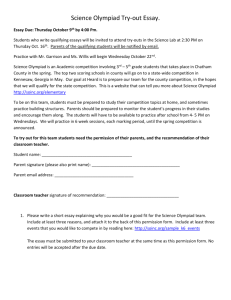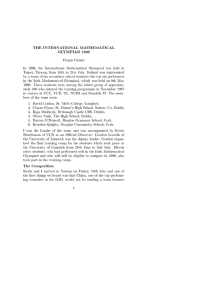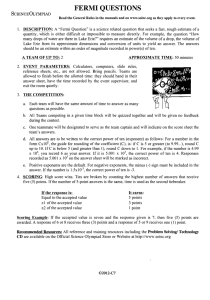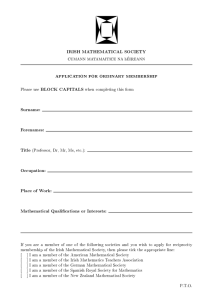Document 11012161
advertisement
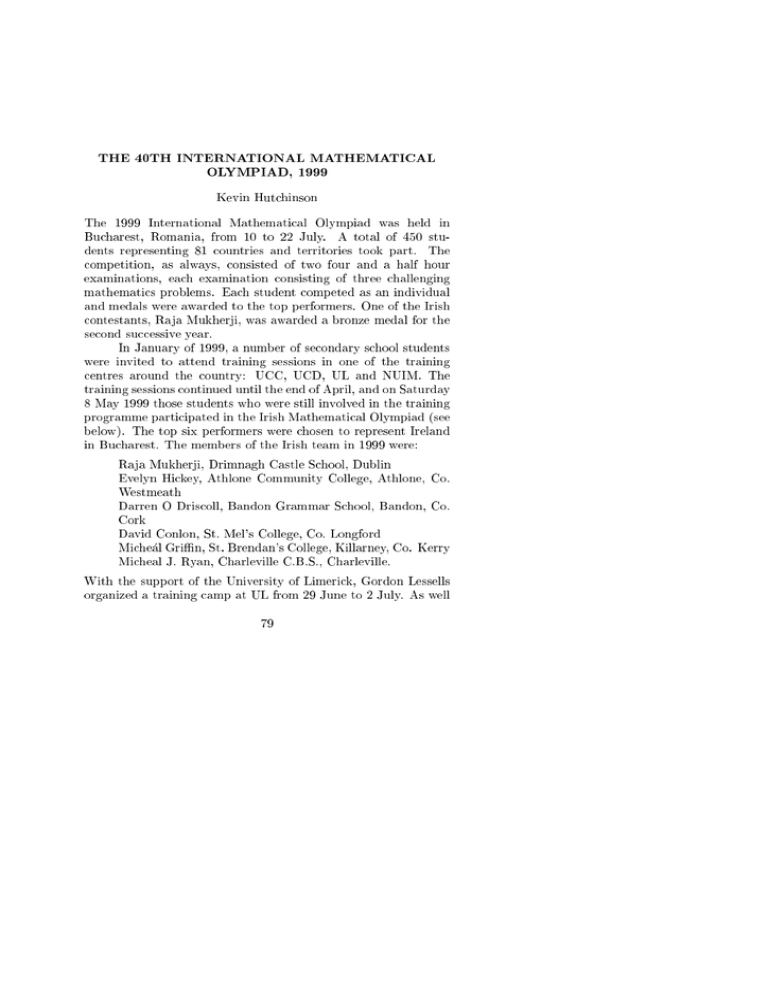
THE 40TH INTERNATIONAL MATHEMATICAL
OLYMPIAD, 1999
Kevin Huthinson
The 1999 International Mathematial Olympiad was held in
Buharest, Romania, from 10 to 22 July. A total of 450 students representing 81 ountries and territories took part. The
ompetition, as always, onsisted of two four and a half hour
examinations, eah examination onsisting of three hallenging
mathematis problems. Eah student ompeted as an individual
and medals were awarded to the top performers. One of the Irish
ontestants, Raja Mukherji, was awarded a bronze medal for the
seond suessive year.
In January of 1999, a number of seondary shool students
were invited to attend training sessions in one of the training
entres around the ountry: UCC, UCD, UL and NUIM. The
training sessions ontinued until the end of April, and on Saturday
8 May 1999 those students who were still involved in the training
programme partiipated in the Irish Mathematial Olympiad (see
below). The top six performers were hosen to represent Ireland
in Buharest. The members of the Irish team in 1999 were:
Raja Mukherji, Drimnagh Castle Shool, Dublin
Evelyn Hikey, Athlone Community College, Athlone, Co.
Westmeath
Darren O Drisoll, Bandon Grammar Shool, Bandon, Co.
Cork
David Conlon, St. Mel's College, Co. Longford
Miheal GriÆn, St. Brendan's College, Killarney, Co. Kerry
Miheal J. Ryan, Charleville C.B.S., Charleville.
With the support of the University of Limerik, Gordon Lessells
organized a training amp at UL from 29 June to 2 July. As well
79
80
IMS Bulletin
43, 1999
as the team members, several others of the top performers in the
Irish Mathematial Olympiad who will be eligible to ompete for
a plae on the team next year were also invited to partiipate in
the training amp.
The Competition
I was the Team Leader and was aompanied by Pat MCarthy
of NUIM as observer. We arrived in Romania on Saturday, 10
July and were met at the airport by the ompetition organizers
and brought to Poiana Brasov, high in the Carpathian mountains.
The team leaders from all of the partiipating ountries met there
to hoose the six problems for the ompetition from a shortlist of
twenty seven problems seleted by the Problem Committee of the
host ountry (Romania). Eah partiipating ountry had been
invited earlier in the year to submit ondentially to the Problem
Seletion Committee a handful of potential problems{whih must
be entirely original and of an appropriate degree of diÆulty{for
the ompetition. It was from this long list of submitted problems
that the twenty seven shortlisted problems had been hosen by the
Problem Seletion ommittee. The nal problem on the shortlist
was one of the problems submitted by Ireland (omposed by Finbarr Holland and T. J. Laey). The jury (i.e. the team leaders)
judged it to be a very beautiful problem, but of too high a level
of diÆulty for the Olympiad. One of the jury members said that
he would like to use it in a ompetition in his own ountry for
graduate students of mathematis.
As soon as they began work, the jury realized that the set
of shortlisted problems was of a higher than average level of difulty and that the resulting nal seletion of six would almost
inevitably lead to a very diÆult ompetition, whih proved to be
the ase. The seletion of problems by the jury proeeded very
eÆiently and the nal six problems were hosen and voted on
by the afternoon of Monday, 12 July. The following morning was
then given over to the translation of the problems from the oÆial English version into all the languages of the ompetition. On
Tuesday afternoon the translations were presented to and ratied
by the jury, thus ompleting this initial stage of their work.
Olympiad 1999
81
In the meantime, the Irish team, aompanied by the deputy
leader, Gordon Lessells, arrived in Buharest on Tuesday, 13 July.
One of the team members, Raja Mukherji, had just arrived home
(in Dublin) the previous day from Bangkok, Thailand, where he
had been awarded a silver medal in the International Chemistry
Olympiad as part of very suessful Irish partiipation in this
event. Indeed, it may have been the strain of travel and prolonged eort whih led to his falling ill shortly after his arrival in
Buharest. He was admitted to hospital on Wednesday and, fortunately, released again the following morning in good health. The
other team members, meanwhile, were shown some of the sights
of Buharest, inluding the Village Museum and the Botani Gardens.
The opening eremony took plae in the Royal Palae Hall
in Buharest on Thursday afternoon, 15 July. The leaders, deputy
leaders, partiipants and organizers were entertained by performanes of musi and dane ranging from traditional Romanian to
modern and lassial.
The exams took plae in the Polytehni University on Friday and Saturday 16 and 17 July. Both mornings, the leaders
were taken to the Polytehni University to answer queries from
the students about the papers during the rst half hour of the
exams. The answer books of the students were delivered to the
leaders at the Hotel Buuresti after the exams both evenings. For
the leaders, deputy leaders and observers, it was at this point
that the long task of studying, and deiphering, their own team's
eorts with the objetive of obtaining as many points as possible
began. Eah of the six problems is assigned a team of `oordinators' from the host ountry, and it is the job of the team leader,
with the help of the deputy leader (and observer, if appliable), to
present the eorts of eah of their team members to the oordinators and to make the ase, if a ase exists, for one or more points.
Preparation for these oordinating sessions an involve quite a lot
of work. Indeed, Pat MCarthy stayed up all night on the rst
evening, poring over the eorts of our team from the rst day's
ompetition.
82
IMS Bulletin
43, 1999
The Results
The diÆulty of the IMO 1999 ompetition was reeted in the
sores, whih were muh lower than average. In most years several ontestants will ahieve the maximum possible sore of 42
points (eah of the six problems is worth 7 points), but this year
the highest sore ahieved{by three ontestants{was 39 points.
Aording to the IMO rules, the top twelfth of the ontestants are
awarded gold medals, the next sixth are awarded silver medals and
the next one quarter are awarded bronze medals. The uto sores
for these three ategories of ontestant were as follows: ontestants soring at least 28 points were awarded a gold medal, those
whose sore was in the range 19 to 27 were awarded a silver medal,
and those whose sore was in the range 12 to 18 obtained a bronze
medal.
Considering the diÆulty of the ontest, whih tested even
the more intensively trained teams from the top performing ountries, the Irish team's performane was more than satisfatory.
The sores of the team members were as follows:
Raja Mukherji
David Conlon
M. J. Ryan
Darren O Drisoll
Evelyn Hikey
Miheal GriÆn
12
9
7
4
3
3
Raja was awarded a bronze medal, having ahieved the uto sore
of 12 points. This, along with all the other medals, was awarded
at the losing eremony, whih took plae at the enormous and
opulent Palae of the Parliament (formerly Ceauesu's palae) in
Buharest. The President of Romania, Emil Constantinesu, was
present. He made a speeh praising the ontestants and organizers
and personally presented some of the top prizes.
83
Olympiad 1999
Here are the two papers of the Irish Mathematial Olympiad
1999, whih were used to selet this year's team, followed by the
papers of the International Mathematial Olympiad. The time
allowed for eah paper of the Irish Mathematial Olympiad was
three hours. The time allowed for eah of the IMO papers was
four and a half hours.
Solutions to the problems of the 40th IMO an be found at
the bak of the Bulletin.
Twelfth Irish Mathematial Olympiad
1.
Saturday, 8 May 1999
First Paper
Find all real values of x whih satisfy
(x + 1
2.
3.
4.
2
p
x
x
+ 1)2
<
2 + 3x + 18
:
(x + 1)2
x
Show that there is a positive number in the Fibonai
sequene whih is divisible by 1000.
[The Fibonai sequene Fn is dened by the onditions
F0 = 0, F1 = 1, Fn = Fn 1 + Fn 2 for n 2. So the
sequene begins 0, 1, 1, 2, 3, 5, 8, 13,: : : ℄
Let D, E , F be points on the sides BC , C A, AB , respetively, of triangle ABC suh that AD is perpendiular to
BC , BE is the angle-bisetor of 6 B and F is the midpoint
of AB . Prove that AD, BE , C F are onurrent if and only
if
2
2 2 )(a + );
a (a
) = (b
where a, b, are the lengths of the sides BC , C A, AB ,
respetively, of triangle ABC .
A square oor onsisting of 10000 squares (100 squares
100 squares{like a large hessboard) is to be tiled. The
only available tiles are retangular 1 3 tiles, tting exatly
over three squares of the oor.
84
IMS Bulletin
5.
6.
8.
(i) If a 2 2 square is removed from the entre of the oor,
prove that the remaining part of the oor an be tiled with
the available tiles.
(ii) If, instead, a 2 2 square is removed from the orner,
prove that the remaining part of the oor annot be tiled
with the available tiles.
[There are suÆiently many tiles available. To tile the oor{
or a portion thereof{means to over it ompletely with the
tiles, eah tile overing three squares, and no pair of tiles
overlapping. The tiles may not be broken or ut.℄
Three numbers a < b < are said to be in arithmeti progression if b = b a.
Dene a sequene un, n = 0, 1, 2, 3,: : : , as follows: u0 = 0,
u1 = 1 and for eah n 1, un+1 is the smallest positive integer suh that un+1 > un and fu0; u1 ; : : : ; un; un+1 g
ontains no three elements whih are in arithmeti progression.
Find u100 .
Seond Paper
Solve the system of (simultaneous) equations
2
2
y = (x + 8)(x + 2);
y
7.
43, 1999
2
(8 + 4x)y + (16 + 16x 5x2 ) = 0:
A funtion f : N ! N (where N denotes the set of positive
integers ) satises
(1) f (ab) = f (a)f (b) whenever the greatest ommon divisor
of a and b is 1,
(2) f (p + q) = f (p) + f (q) for all prime numbers p and q.
Prove that f (2) = 2, f (3) = 3 and f (1999) = 1999.
Let a, b, and d be positive real numbers whose sum is 1.
Prove that
2
2
2
2
b
d
a
+
+
+
21 ;
a+b
b+
+d
d +a
85
Olympiad 1999
9.
10.
with equality if and only if a = b = = d = 1=4.
Find all positive integers m with the property that the
fourth power of the number of (positive) divisors of m equals
m.
ABC DE F is a onvex (not neessarily regular) hexagon
with AB = BC , C D = DE , E F = F A and
6
ABC
+6
+6
C DE
EF A
= 360Æ:
Prove that the perpendiulars from A, C and E to F B , BD
and DF respetively are onurrent.
Fortieth International Mathematial Olympiad
First Day{16 July 1999
1. Determine all nite sets S of at least three points in the
plane whih satisfy the following ondition:
for any two distint points A and B in S , the perpendiular
bisetor of the line segment AB is an axis of symmetry for
S.
2. Let n be a xed integer, with n 2.
(a) Determine the least onstant C suh that the inequality
X
1i<jn
0
14
X
2) iA
j
i j (x2i + x
x x
C
1in
x
holds for all real numbers x1 , : : : , xn 0.
(b) For this onstant C , determine when equality holds.
(Editor's note: in onnetion with this problem, see Finbarr
Holland's artile on pp.73{78 of this Bulletin.)
3. Consider an n n square board, where n is a xed even
positive integer. The board is divided into n2 unit squares.
We say that two dierent squares on the board are adjaent
86
IMS Bulletin
43, 1999
if they have a ommon side. N unit squares on the board
are marked in suh a way that every square (marked or
unmarked) on the board is adjaent to at least one marked
square.
Determine the smallest possible value of N .
4.
Seond Day{17 July 1999
Determine all pairs (n; p) of positive integers suh that p is
a prime, n 2p, and
(p 1)n+1 is divisible by np 1 :
5.
6.
Two irles 1 and 2 are ontained inside a irle , and are
tangent to at the distint points M and N , respetively.
1 passes through the entre of 2 . The line passing through
the two points of intersetion of 1 and 2 meets at A and
B . The lines M A and M B meet
1 at C and D respetively.
Prove that C D is tangent to 2 .
Determine all funtions f : R ! R suh that
(
f x
( )) = f (f (y)) + xf (y) + f (x) 1
f y
for all x and y in R .
Kevin Huthinson
Department of Mathematis
University College
Beleld
Dublin 4
